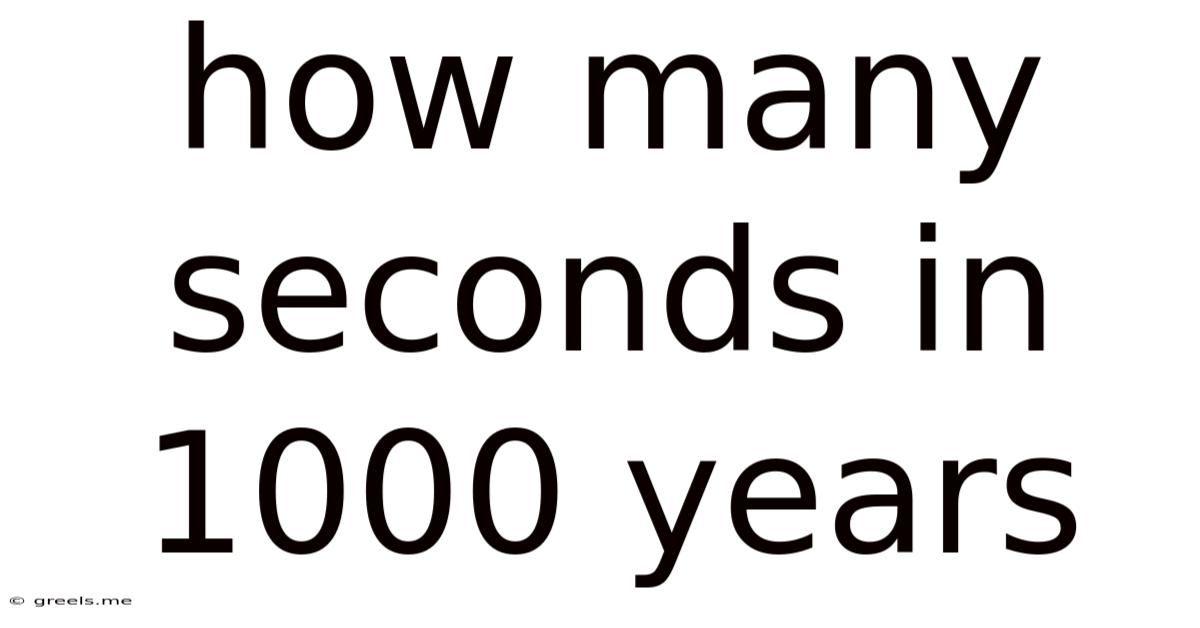How Many Seconds In 1000 Years
Greels
May 23, 2025 · 4 min read

Table of Contents
How Many Seconds Are There in 1000 Years? A Deep Dive into Time Calculation
Have you ever wondered just how much time 1000 years encompasses? It's a question that sparks curiosity about the vastness of time and the sheer number of moments contained within a millennium. This article delves into the calculation of seconds in 1000 years, exploring the intricacies of timekeeping and offering a fascinating perspective on the scale of a millennium.
Understanding the Fundamentals: Units of Time
Before jumping into the calculation, let's establish a firm understanding of the units of time involved:
- Seconds: The base unit of time in the International System of Units (SI).
- Minutes: 60 seconds make up one minute.
- Hours: 60 minutes constitute one hour.
- Days: A day typically consists of 24 hours, though this can vary slightly depending on the definition (solar day vs. sidereal day). We'll use the standard 24-hour day for this calculation.
- Years: A year is approximately 365.25 days, accounting for leap years. This average is crucial for accurate long-term calculations.
The Calculation: Seconds in 1000 Years
Calculating the number of seconds in 1000 years requires a step-by-step approach, meticulously converting each larger unit of time into seconds:
-
Years to Days: 1000 years * 365.25 days/year ≈ 365,250 days
-
Days to Hours: 365,250 days * 24 hours/day = 8,766,000 hours
-
Hours to Minutes: 8,766,000 hours * 60 minutes/hour = 525,960,000 minutes
-
Minutes to Seconds: 525,960,000 minutes * 60 seconds/minute = 31,557,600,000 seconds
Therefore, there are approximately 31,557,600,000 seconds in 1000 years.
Accounting for Leap Years: A Closer Look
The calculation above uses the average number of days in a year (365.25). Let's delve deeper into the nuances of leap years to understand their impact on the overall calculation:
-
Leap Years: Leap years occur every four years, adding an extra day (February 29th) to the calendar. This adjustment is necessary to keep the calendar year synchronized with the Earth's revolution around the Sun.
-
Exceptional Cases: Century years (like 1900 and 2100) are not leap years unless they are divisible by 400. This further refines the accuracy of the calculation.
The actual number of leap years in a 1000-year period might slightly deviate from the average, leading to a minor adjustment in the total number of seconds. However, for practical purposes, the calculation using 365.25 days/year provides a sufficiently accurate estimate.
The Immensity of a Millennium: A Perspective on Time
The sheer magnitude of 31,557,600,000 seconds is difficult to grasp. To put this number into perspective, consider the following:
-
Human Lifespan: A typical human lifespan is around 70-80 years. In the context of 1000 years, this represents a tiny fraction of time.
-
Historical Events: 1000 years encompasses a vast span of history, witnessing the rise and fall of civilizations, technological advancements, and countless societal shifts.
-
Cosmic Time: On a cosmic scale, 1000 years is a mere blink of an eye. Stars live and die over millions or billions of years.
Exploring Applications and Further Calculations
Understanding the number of seconds in 1000 years has applications beyond simple curiosity. It can be useful in various fields:
-
Scientific Research: Calculations involving radioactive decay, astronomical events, and geological processes often require precise time estimations.
-
Software Engineering: Precise timekeeping is crucial for systems involving scheduling, data logging, and event processing.
-
Financial Modeling: Complex financial models might involve long-term projections that necessitate accurate time calculations.
Furthermore, we can extend the calculation to other time periods:
-
Seconds in 1 million years: Multiply the seconds in 1000 years by 1000.
-
Seconds in 1 billion years: Multiply the seconds in 1000 years by 1 million.
These extended calculations offer a truly mind-boggling perspective on the immensity of geological and cosmic timescales.
Conclusion: A Journey Through Time
This in-depth exploration of the number of seconds in 1000 years has revealed not only the mathematical calculation but also the immense scale of time itself. From the intricacies of leap years to the vastness of historical events and cosmic processes, this article highlights the significance of precise timekeeping and offers a fascinating perspective on the passage of time. The sheer number – 31,557,600,000 seconds – serves as a reminder of the vastness of a millennium and the fleeting nature of our existence within this grand timeline. Understanding this magnitude allows us to appreciate the importance of making the most of each precious moment.
Latest Posts
Related Post
Thank you for visiting our website which covers about How Many Seconds In 1000 Years . We hope the information provided has been useful to you. Feel free to contact us if you have any questions or need further assistance. See you next time and don't miss to bookmark.